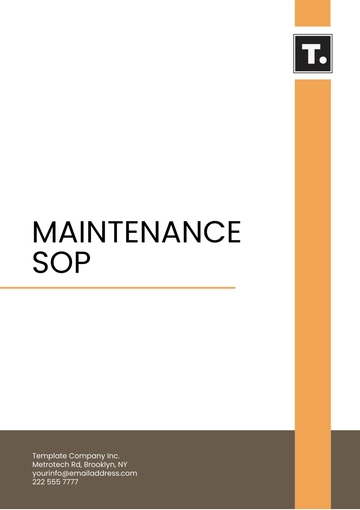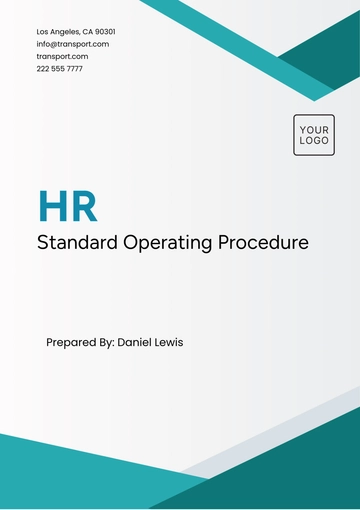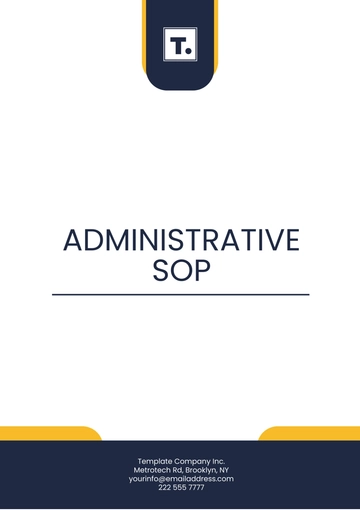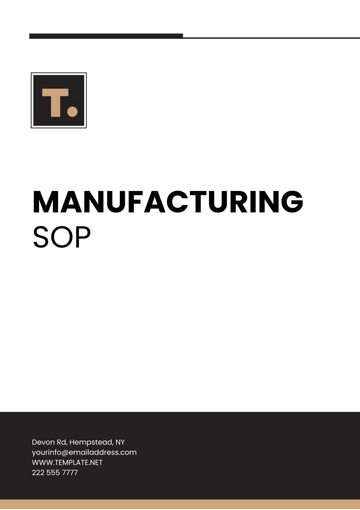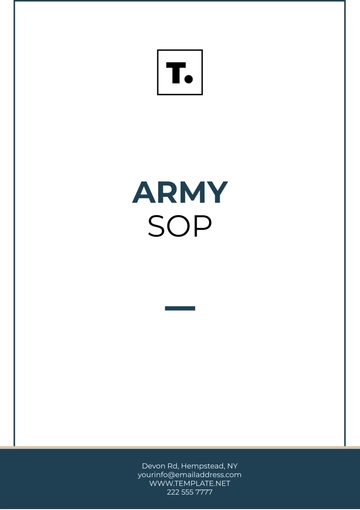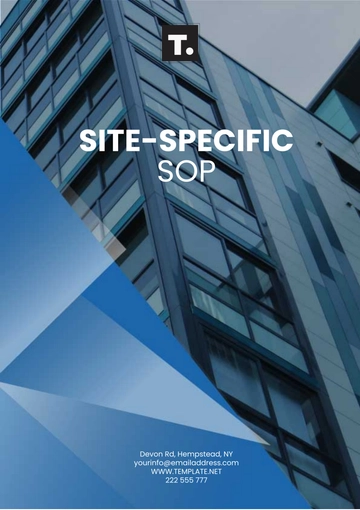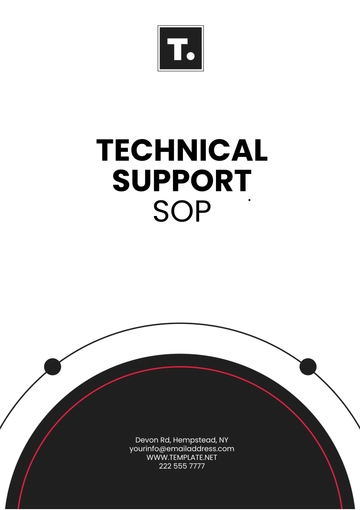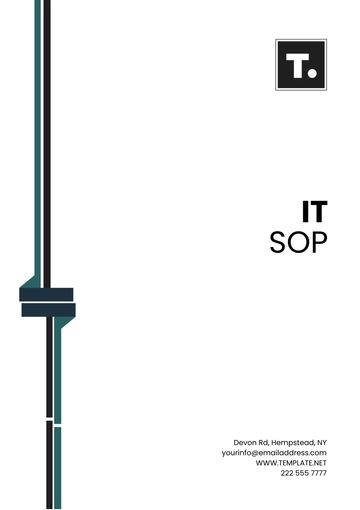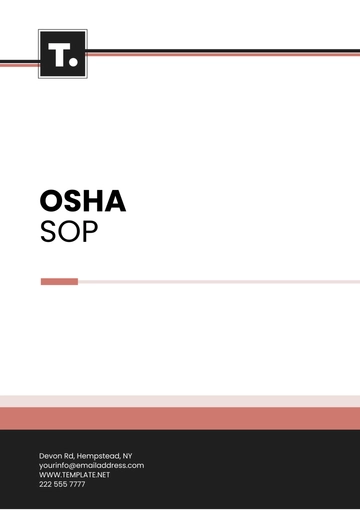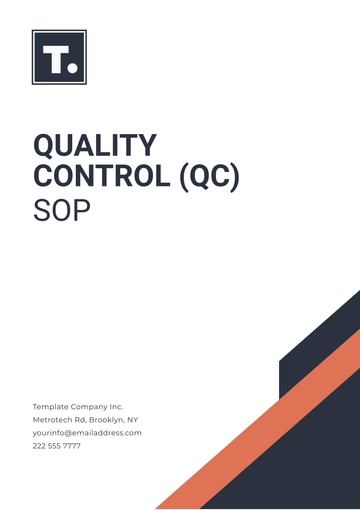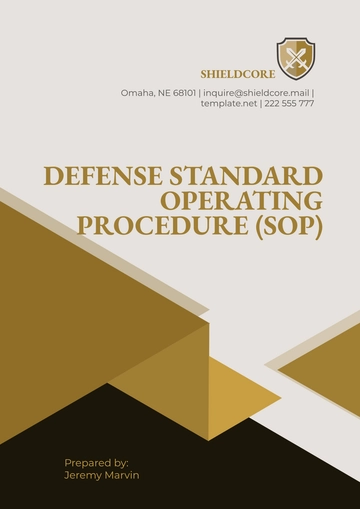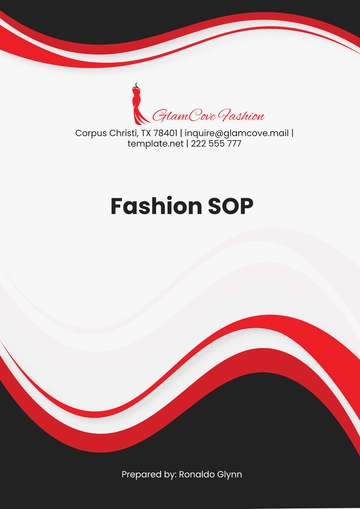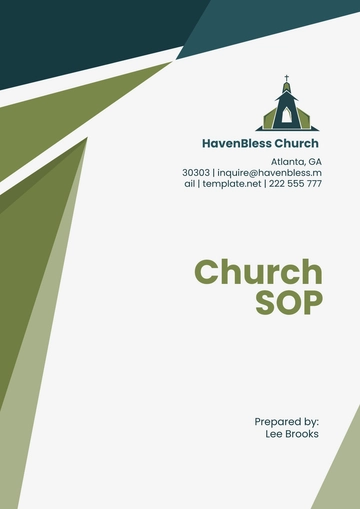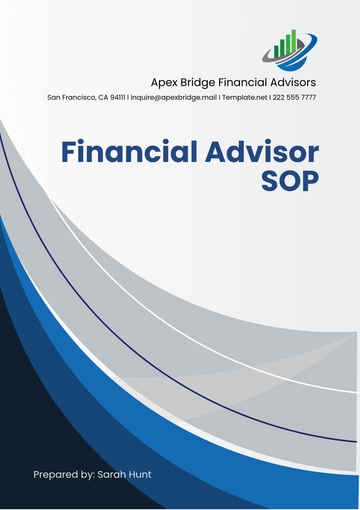Free Agriculture Financial SOP
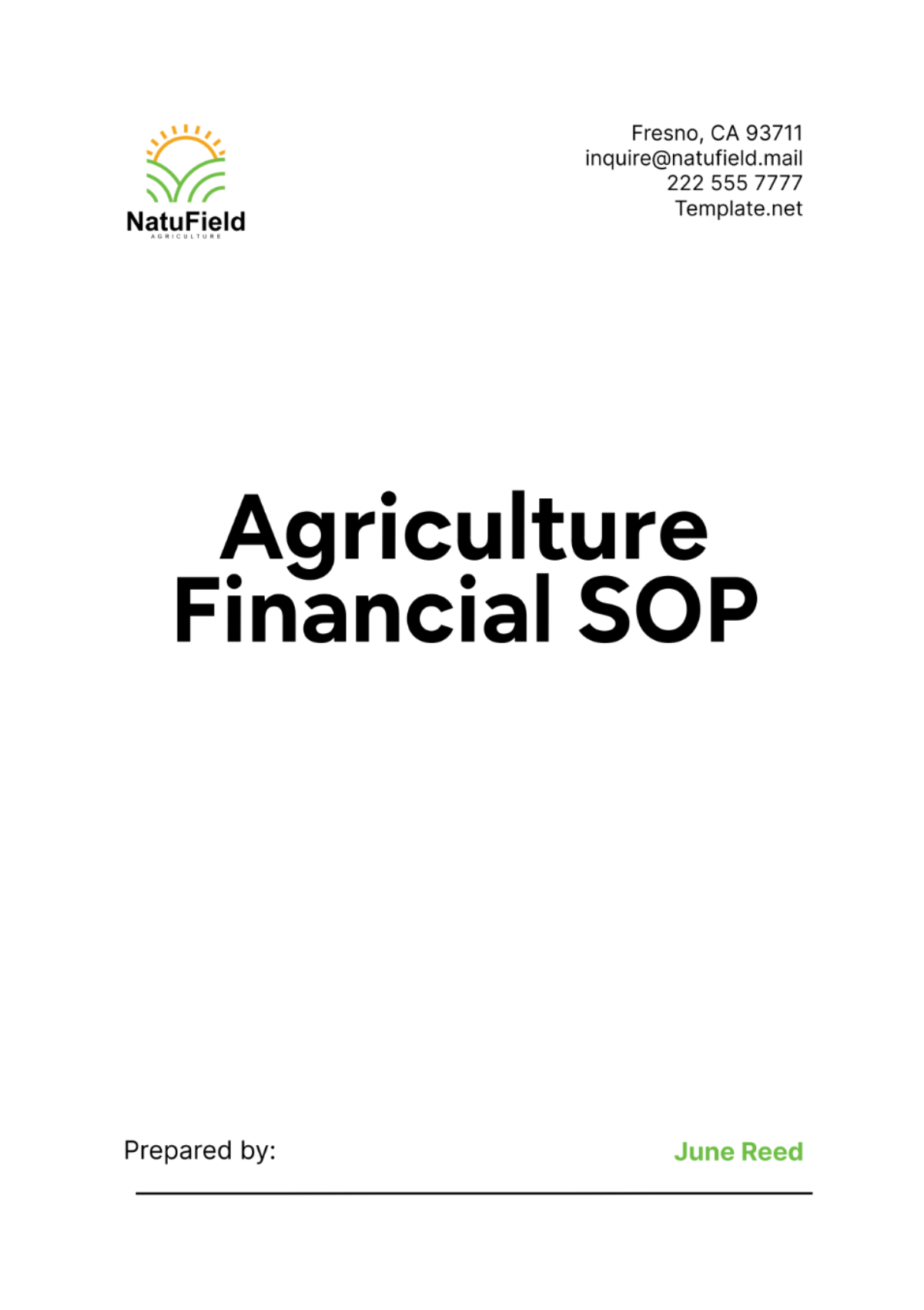
I. Introduction
A. Purpose of the SOP
This SOP serves to standardize financial procedures across [Your Company Name]'s agricultural operations, promoting efficiency, accuracy, and compliance with regulatory requirements. By establishing clear guidelines, it aims to enhance financial transparency and accountability throughout all financial transactions and reporting processes. Additionally, the SOP ensures alignment with industry best practices to support sustainable growth and profitability in agricultural ventures.
B. Scope of the SOP
The scope of this SOP encompasses all financial activities within [Your Company Name], including budgeting, accounting practices, purchasing, procurement, financial reporting, and risk management specific to agricultural operations. It applies to all employees involved in financial decision-making and execution across departments, ensuring consistent practices that uphold [Your Company Name]'s financial objectives and organizational values.
C. Definitions and Terminology Used
Annual Budgets: Comprehensive financial plans outlining projected revenues, expenses, and resource allocation for agricultural activities within a fiscal year.
Accounts Payable: Obligations to suppliers and vendors for goods and services received but not yet paid for.
Accounts Receivable: Funds owed to [Your Company Name] by customers or clients for goods sold or services rendered within credit terms.
Internal Audit: Independent examination of financial records and processes to assess compliance with SOPs and regulatory standards.
Capital Expenditure: Investments in long-term assets crucial for operational success, such as land, buildings, and specialized equipment.
II. Financial Planning and Budgeting
A. Development of Annual Budgets
The Finance Department, in collaboration with department heads and agricultural experts, shall develop annual budgets based on historical data, market trends, and anticipated changes in agricultural inputs and outputs. These budgets will serve as a roadmap for financial decision-making and resource allocation throughout the fiscal year.
Budget development will include contingency plans for unforeseen events affecting agricultural production or market conditions, ensuring resilience and adaptability in financial planning.
B. Forecasting Revenue and Expenses
Revenue forecasts will integrate factors such as crop yield projections, livestock production estimates, and expected sales volumes based on market demand and pricing trends. This data-driven approach will enable [Your Company Name] to anticipate income streams and optimize pricing strategies accordingly.
Expense forecasting will consider variable costs like seed, fertilizer, irrigation, and labor expenses, aligning expenditure forecasts with production goals and operational needs to maintain profitability and financial stability.
C. Budget Allocation for Agricultural Operations
Allocation of budgetary resources will prioritize essential expenditures, such as sustainable farming practices, technology upgrades, and infrastructure maintenance critical for enhancing agricultural productivity and efficiency.
Budget allocations will undergo periodic reviews and adjustments based on performance metrics, feedback from operational departments, and emerging market opportunities, ensuring strategic alignment with [Your Company Name]'s long-term growth objectives.
III. Accounting Practices
A. Recording Financial Transactions
All financial transactions within [Your Company Name]'s agricultural operations will be recorded promptly and accurately in the designated accounting software. This includes transactions related to purchases, sales, payroll, and capital investments, ensuring a comprehensive and real-time view of financial activities.
Documentation accompanying transactions, such as invoices, receipts, and payment authorizations, will be systematically archived and cross-referenced to facilitate efficient audit trails and compliance with regulatory standards.
B. Accounts Payable Procedures
Accounts Payable procedures will adhere to established policies and procedures, requiring thorough verification of invoices against purchase orders and contractual agreements. Payment processing will prioritize timely settlements to maintain favorable supplier relationships and leverage discounts where applicable.
Vendor communications and dispute resolutions will be handled professionally and promptly, aiming to resolve discrepancies and maintain integrity in financial transactions while safeguarding [Your Company Name]'s financial interests.
C. Accounts Receivable Management
Accounts Receivable management will focus on proactive invoicing, diligent tracking of customer payments, and effective credit management strategies to minimize overdue balances and optimize cash flow. Periodic aging analyses and collection efforts will be conducted to expedite revenue realization and mitigate potential bad debt risks.
Customer relationships will be nurtured through transparent communication and flexible payment options, fostering long-term partnerships that support [Your Company Name]'s financial sustainability and growth objectives.
IV. Purchasing and Procurement
A. Vendor Selection and Approval Process
The Procurement Department will maintain a robust vendor evaluation framework, assessing factors such as reliability, product quality, pricing competitiveness, and adherence to sustainability standards. Approved vendors will undergo periodic reviews to ensure continued alignment with [Your Company Name]'s procurement objectives and operational requirements.
New vendor onboarding will involve comprehensive due diligence, including background checks, reference verifications, and contract negotiations conducted in collaboration with legal and compliance teams, safeguarding [Your Company Name]'s interests and minimizing procurement risks.
B. Purchase Order Procedures
Purchase order issuance will follow a standardized process, requiring clear specifications, quantity requirements, delivery timelines, and budgetary approvals. These parameters will be communicated effectively to vendors to facilitate accurate fulfillment and invoice reconciliation.
Purchase order tracking mechanisms will be implemented to monitor order status, receipt of goods or services, and adherence to contractual terms, ensuring timely inventory replenishment and operational continuity across [Your Company Name]'s agricultural facilities.
C. Inventory Management Guidelines
Inventory management practices will emphasize real-time visibility and accuracy through systematic inventory counts, reconciliations, and utilization assessments. Critical inventory levels will be monitored closely to prevent stockouts and minimize carrying costs while optimizing supply chain efficiency.
Inventory data analytics will inform strategic decisions related to procurement, production planning, and distribution logistics, enabling [Your Company Name] to align inventory levels with demand forecasts and seasonal fluctuations effectively.
V. Financial Reporting
A. Preparation of Financial Statements
Monthly, the Finance Department will prepare comprehensive income statements, balance sheets, and cash flow statements to provide a clear overview of [Your Company Name]'s financial performance. These statements will adhere to Generally Accepted Accounting Principles (GAAP) and reflect accurate data derived from timely and reliable financial records.
Quarterly and annually, financial statements will undergo rigorous review by senior management and external auditors to ensure accuracy, transparency, and compliance with regulatory requirements. Variance analysis and key performance indicators (KPIs) will be included to facilitate strategic decision-making and performance evaluation.
B. Frequency and Distribution of Financial Reports
Monthly financial reports will be distributed to department heads and senior management to facilitate informed decision-making and operational planning. These reports will highlight trends, variances against budgets, and actionable insights to optimize resource allocation and financial outcomes.
Annual financial reports, including comprehensive analyses of profitability, liquidity, and financial health metrics, will be disseminated to stakeholders, shareholders, and regulatory authorities as per legal requirements and transparency initiatives.
C. Financial Analysis and Performance Metrics
Finance will conduct in-depth financial analysis using ratios and metrics such as return on investment (ROI), gross margin, and debt-to-equity ratio to evaluate [Your Company Name]'s financial health and operational efficiency. These analyses will identify strengths, weaknesses, and areas for improvement, guiding strategic initiatives and resource allocation decisions.
Performance metrics will be benchmarked against industry standards and historical data to assess competitiveness and sustainability in agricultural markets. Regular reviews of financial strategies and operational plans will incorporate findings from financial analysis to drive continuous improvement and maximize shareholder value.
VI. Expense Management
A. Expense Authorization and Approval
Department heads will be responsible for authorizing expenditures within allocated budgets, ensuring alignment with operational priorities and financial goals. Authorization processes will involve thorough review and adherence to established spending limits and guidelines to mitigate risks and optimize resource allocation.
Finance will oversee expense approvals exceeding predefined thresholds, conducting cost-benefit analyses and assessing impact on profitability and cash flow. Exceptions to budgetary constraints will require justification and approval through hierarchical channels to maintain fiscal discipline and operational efficiency.
B. Tracking and Controlling Costs
Finance will implement robust cost-tracking mechanisms to monitor expenditure patterns, identify variances, and address discrepancies promptly. Cost-control strategies will focus on optimizing operational efficiencies, negotiating favorable terms with suppliers, and leveraging economies of scale to minimize expenses without compromising quality or service delivery.
Continuous monitoring of cost trends and budgetary adherence will enable proactive adjustments to spending forecasts, ensuring financial stability and resilience in dynamic agricultural environments. Regular reviews of cost-saving initiatives and procurement strategies will foster a culture of cost consciousness and operational excellence across [Your Company Name]'s organizational framework.
C. Capital Expenditure Planning and Approval
Capital expenditure proposals will undergo comprehensive evaluation, assessing strategic alignment, anticipated returns, and risk considerations before approval. Investment decisions will prioritize projects enhancing agricultural productivity, sustainability, and technological advancements critical for long-term growth and competitive advantage.
Finance will collaborate with operational stakeholders to develop detailed business cases and financial projections supporting capital expenditure requests. Post-implementation evaluations will monitor project milestones, cost overruns, and benefits realization to optimize capital allocation and ensure alignment with [Your Company Name]'s strategic objectives and financial sustainability.
VII. Risk Management
A. Identification of Financial Risks
Finance will conduct regular assessments to identify and evaluate financial risks inherent to agricultural operations, including market volatility, commodity price fluctuations, and regulatory changes impacting revenue streams and cost structures. Risk identification processes will incorporate historical data, scenario analyses, and industry insights to anticipate potential threats and vulnerabilities.
Cross-functional collaboration with operational teams and external advisors will enhance risk visibility and enable proactive mitigation strategies, safeguarding [Your Company Name]'s financial assets and market position. Risk registers and heat maps will document identified risks, their likelihood, potential impact, and mitigation actions to promote risk awareness and informed decision-making.
B. Mitigation Strategies
Mitigation strategies will be tailored to mitigate identified financial risks, emphasizing diversification of revenue sources, hedging strategies, and insurance coverage tailored to agricultural risks. Contingency planning and business continuity measures will be developed to minimize disruptions and ensure operational resilience in adverse market conditions.
Regular reviews and updates of risk mitigation plans will align with strategic objectives and regulatory requirements, integrating feedback from risk assessments and stakeholder engagements to optimize risk management frameworks. Training programs will educate employees on risk awareness and response protocols to enhance organizational resilience and adaptability to changing agricultural landscapes.
C. Insurance Coverage and Claims Handling
Finance will maintain comprehensive insurance policies covering property, liability, crop damage, and business interruption specific to [Your Company Name]'s agricultural activities. Insurance coverage will be regularly reviewed and adjusted to align with evolving operational risks and regulatory requirements, ensuring adequate protection against financial losses and unforeseen events.
Claims handling procedures will prioritize timely and accurate submission of claims, leveraging insurance provider relationships and legal expertise to expedite settlements and minimize financial impacts. Claims data analytics and post-claim reviews will inform continuous improvement of insurance strategies and risk financing approaches, enhancing [Your Company Name]'s resilience and financial preparedness in the agricultural sector.
VIII. Auditing and Compliance
A. Internal Audit Procedures
The Internal Audit Department will conduct periodic audits of financial processes, controls, and compliance with SOPs and regulatory standards. Audit plans will be risk-based, focusing on high-risk areas such as financial reporting accuracy, fraud prevention, and adherence to internal policies.
Audit findings and recommendations will be documented in audit reports, communicated to senior management and audit committees for corrective action, and monitored through follow-up reviews to ensure implementation of corrective measures and continuous improvement in financial governance and controls.
B. Compliance with Regulatory Requirements
Finance will monitor changes in local, state, and federal regulations impacting agricultural finance, taxation, and reporting obligations. Compliance initiatives will include regular updates to SOPs, employee training on regulatory changes, and proactive engagement with regulatory authorities to maintain [Your Company Name]'s adherence to legal requirements.
External audits and regulatory inspections will be facilitated by maintaining comprehensive documentation, supporting evidence of compliance, and timely submission of required reports and filings. Collaborative efforts with legal counsel and industry associations will enhance [Your Company Name]'s proactive approach to regulatory compliance, ensuring operational transparency and integrity in agricultural financial practices.
C. Documentation and Record-Keeping Standards
Finance will establish robust documentation and record-keeping protocols for financial transactions, audit trails, and compliance documentation. Records will be maintained in accordance with retention policies, ensuring accessibility, accuracy, and confidentiality of sensitive financial information.
Electronic document management systems and secure data storage solutions will be utilized to safeguard financial records from unauthorized access, cyber threats, and physical damage. Periodic reviews of record-keeping practices and technology upgrades will enhance data integrity and compliance readiness, supporting [Your Company Name]'s commitment to operational excellence and stakeholder trust.
IX. Financial Controls
A. Establishment of Financial Controls
Finance will design and implement internal controls to prevent errors, detect fraud, and ensure the accuracy and reliability of financial reporting. Control activities will include segregation of duties, dual authorization for financial transactions, and regular reconciliation of accounts to mitigate operational risks and safeguard [Your Company Name]'s financial assets.
Control assessments and reviews will be conducted periodically to evaluate the effectiveness of control mechanisms and identify opportunities for enhancement. Continuous monitoring of control deficiencies and implementation of corrective actions will strengthen [Your Company Name]'s internal control environment, fostering confidence in financial integrity and compliance with regulatory requirements.
B. Fraud Prevention and Detection Measures
Finance will promote a culture of ethics and integrity across [Your Company Name], emphasizing awareness of fraud risks and adherence to the Code of Conduct. Employee training programs will educate staff on recognizing red flags, reporting suspicious activities, and maintaining confidentiality to prevent fraud incidents.
Proactive monitoring and data analytics tools will be utilized to detect anomalies, unusual patterns, and potential fraudulent activities in financial transactions. Investigations of reported concerns will be conducted promptly, collaborating with legal counsel and law enforcement agencies as necessary to mitigate fraud risks and protect [Your Company Name]'s reputation and financial interests.
C. Ethical Standards and Code of Conduct
Finance will uphold high ethical standards and professional conduct in all financial dealings and interactions with stakeholders, ensuring transparency, fairness, and integrity. Compliance with the Code of Conduct will be enforced through regular assessments, performance evaluations, and disciplinary actions for violations to maintain a culture of trust and accountability.
Ethics training and communication initiatives will promote awareness of ethical dilemmas, encourage ethical decision-making, and reinforce [Your Company Name]'s commitment to ethical business practices. Continuous dialogue with employees, suppliers, and business partners will foster mutual respect and ethical behavior, enhancing [Your Company Name]'s reputation as a responsible corporate citizen in the agricultural industry.
X. Training and Communication
A. Training Programs for Financial Personnel
Finance will develop and deliver comprehensive training programs tailored to the specific roles and responsibilities of financial personnel within [Your Company Name]. Training topics will include SOP compliance, financial reporting standards, risk management practices, and technological advancements relevant to agricultural finance.
Continuous professional development opportunities will be offered to enhance financial literacy, technical skills, and leadership competencies among staff, promoting career growth and organizational effectiveness in [Your Company Name]'s dynamic agricultural environment.
B. Communication of SOP Updates and Revisions
Updates and revisions to SOPs will be communicated proactively to relevant stakeholders through departmental meetings, internal memos, and digital platforms. Clear instructions and training sessions will accompany SOP changes to ensure understanding and implementation across all levels of the organization.
Feedback mechanisms and surveys will solicit input from employees regarding the effectiveness and practicality of SOPs, facilitating continuous improvement and alignment with [Your Company Name]'s evolving business needs and strategic objectives.
C. Promotion of Financial Literacy Across Departments
Finance will collaborate with department heads to promote financial literacy and understanding of key financial principles among non-financial personnel. Tailored workshops and educational resources will demystify financial concepts, encourage informed decision-making, and foster a culture of financial accountability and ownership throughout [Your Company Name].
Cross-functional team collaborations and knowledge-sharing initiatives will enhance interdisciplinary understanding of financial impacts on operational activities, promoting synergy and alignment in achieving [Your Company Name]'s financial and strategic goals in the competitive agricultural marketplace.
- 100% Customizable, free editor
- Access 1 Million+ Templates, photo’s & graphics
- Download or share as a template
- Click and replace photos, graphics, text, backgrounds
- Resize, crop, AI write & more
- Access advanced editor
Discover efficiency with the Agriculture Financial SOP Template from Template.net. This editable and customizable SOP offers a streamlined approach to managing financial operations in agriculture. Tailor procedures effortlessly with the AI Editor Tool, ensuring compliance and enhancing financial transparency. Ideal for agricultural enterprises seeking standardized financial practices to optimize performance and mitigate risks effectively.




